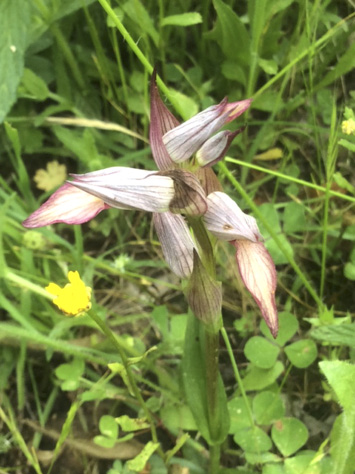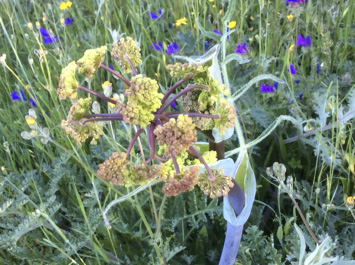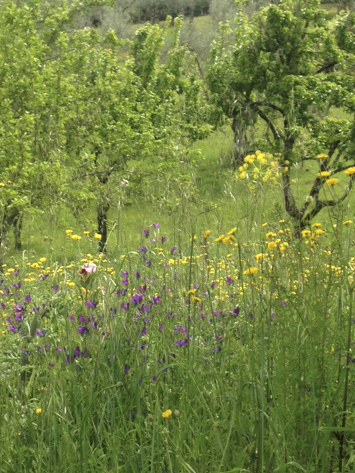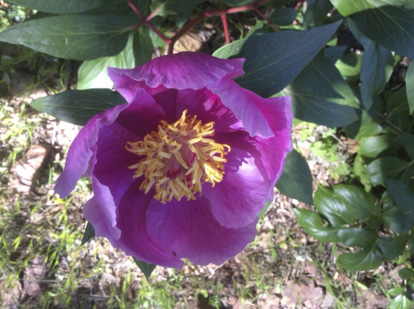Bejewel: vb, to decorate, as with jewels. At this time of the year, the National Park of Sierra de Aracena y los Picos de Aroche is an overwhelming feast for the eyes as it is ‘bejewelled and bedecked’ with thousands of wild flowers amongst hillsides of ancient olives, Mediterranean oaks (Quercus ilex), cork oaks (Quercus suber) and sweet chestnut.
In the most westerly province of Andalucia, bordering Portugal to the west, the National Park forms part of the Sierra Morena, the range of hills separating Andalucia from the rest of Spain. Before we left for a walking holiday there recently we were on Amazon at the last minute trying to find the ultimate Mediterranean Fauna and Flora guide. Luckily, we didn’t find one as this area, rising to 3,000 feet, has a higher rainfall than the rest of the province and is cooler in the summer too. So this microclimate provides temperate conditions and an acid soil for plants rather than purely Mediterranean conditions. However, the traditional methods of farming, and in particular the rearing of black Iberian pigs, means that the wild flowers, birds and butterflies in the area are phenomenal.
We were there just as the spring bulbs were going over but wild daffodils, Hoop Petticoat Narcissus or Cyclamen-flowered Narcissus all jostle for space on the hillsides earlier in the year. Never mind, we spotted a few lovely little Star-of-Bethlehem in the woods, so pretty with a bright green strip marking the little white flower, as well as plenty of blue tassel hyacinths (Muscari comosum) in the olive groves and wild alliums dotted around. I would have loved to see Nectaroscordum siculum growing in the wild. They are so lovely in our gardens with their long elegant stems, each topped with bell shaped greenish-maroon flowers, but maybe we were too high for them.
We walked to Cortalazor through eucalyptus plantations and acres of French lavender, L. stoechas, and everywhere were clouds of Cistus ladanifer, the gum rock rose. It was quite a sight, growing to about eight feet tall, with masses of large, papery flowers with a distinctive red to maroon spot at the base of each petal surrounding bold yellow stamens. Cistus give off a sticky resin which is used in both herbal medicines and perfumes. They can withstand summer drought and cold weather and are perfect for growing in gravelly Mediterranean gardens, city courtyards and sheltered well-drained spots. The scent is described as ‘sweet amber’ and as we meandered along the old mule tracks it was incredibly heady. And then on through a valley of Iranian phlomis, P. herba-venti, perfectly adapted for hot conditions with grey green downy leaves and rich rosy flowers held in whorls. And then clouds of Euphorbia sp. dotted with French lavender and tall blue iris. I thought at the time that it would be fun to replicate this combination at home as the blue of the iris looked so stunning with the lime green euphorbia.
And Paeonia coriacea growing both in dappled shade under the cork oaks and in the open meadows were in full flower. Gosh, I hope I’ve identified them correctly! The centre of the rose pink flowers is particularly gorgeous with absolutely masses of stamens in a sort of mad hair day arrangement. These can be grown in our gardens and seeds are available but I see that one rhizome can cost as much as £50.00 – best to go down the seed route, combined with a lot of patience.
And growing amongst the sweet chestnuts, harvested in the autumn and taken down to Seville to be roasted and sold in the streets, were white helleborines and sword leaved helleborines, members of the orchid family, growing through the leaf litter. Never very many, maybe a group of two or three. And whilst the white helleborine is the most common of the family, they only flower after ten years of growth. The ones we saw must have been relatively young as they can eventually form solid, floriferous clumps given the right conditions. A chestnut forest is obviously the place to be.
It was surprising to see tree germander, Teucrium fruticans, growing in the shade in the same chestnut forest. The RHS recommend growing them in full sun and, with their silvery grey leaves and hairy stems, they are perfectly adapted for sunny, dry conditions. Having said that, their growth was much more straggly in these woodlands than it is in our gardens where it makes a wonderful silvery shrub which can either be left to grow loosely, trimmed into shapes or grown as a hedge. Our sort of winter wet doesn’t help though but added drainage in the form of plenty of grit, would prolong life and mean that you could enjoy the little tubular flowers for months. The ones we saw in Spain were violet blue but I think that the dark blue cultivar, T. fruticans ‘Azureum’, makes a striking plant.
We didn’t need to go on all-day hikes to experience a horticultural high. Back at the Finca, horses and one little donkey, Violette, were munching their way through bright yellow field marigolds dotted with purple Viper’s bugloss, Echium plantagineum, which is different from the blue Viper’s bugloss we see down at Dungeness or Rye Harbour. But wander on into these meadows and there they were – the tongue orchids or serapias – that was the best treat. At this stage, six large Andalucian horses and one little donkey had to be shooed away to carry on with their supper in another part of the field. Let’s hope that these orchids are unpalatable and will flower a little longer.
TEST TEST
TEST
 TEST
TEST

- words: Sue Whigham
You may also like
In the Night Garden
Jo Arnell explains how to make the most of your outdoor space once darkness falls Some enchanted evening you may see me outside – mainly searching for slugs in the garden, because the cool hours of night are when they...
Contain your excitement
Jen Stuart-Smith discusses how to get creative with your pots and planters My love affair with plants started with houseplants when I was a child. As my bedroom windowsill overflowed – resulting, occasionally, in waking up with compost under my...
More than just a pretty face
Jen Stuart-Smith explores the multiple uses of some easy-to-grow garden favourites When you grow flowers for their beauty, shape and colour it can be easy to forget all the other qualities they have to offer. Some are edible, others provide...










